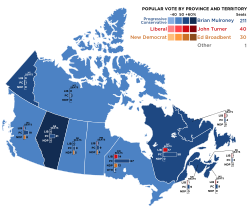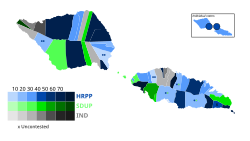Notable examples
Australia
Local and mayoral elections:
- 2008 Brisbane City Council election – The Liberal Party won a landslide victory over the Labor Party. Campbell Newman was re-elected Lord Mayor of Brisbane with 66.1% of the two-party-preferred vote, with a swing of 13.7%. [7] The LNP won 16 of the 26 wards.

- 2021 Mandurah City Council election – Rhys Williams was re-elected Mayor of Mandurah with 85% of the vote. [8]
State and territory elections:
- 2021 Western Australian state election – Mark McGowan led the Labor Party to win 53 out of the 59 seats in the lower house. The Labor Party had a primary vote of 59.92% and a two-party-preferred vote of 69.68%. The National Party won 4 seats and the Liberal Party won 2 seats, making the National Party the official opposition, the first time they had held this status since the 1940s. To date, the election is the most decisive result at any Australian state or federal election since Federation, in terms of both percentage of lower house seats controlled by the governing party (89.8%) and two-party preferred margin. [9] [10]
Canada
In a Canadian federal election, a landslide victory occurs when a political party gains a significant majority of the House of Commons of Canada.
Landslide victories may also occur during provincial elections, and territorial elections in Yukon. Landslide victories are not possible for territorial elections in the Northwest Territories, and Nunavut, as its members are elected without reference to political parties, operating as a consensus government.
National landslide victories
The following Canadian federal elections resulted in landslide victories: [11]
- 1917 – The Conservatives, led by Robert Borden, won 153 seats (an increase of 21) and gained a majority of 14, while the Liberals, led by Wilfrid Laurier, won just 82 (a decrease of 3).
- 1935 – The Liberals, led by William Lyon Mackenzie King, won 171 seats (an increase of 34) and gained a majority of 50, while the Conservatives, led by R. B. Bennett, won just 39 (a decrease of 98).
- 1940 – The Liberals, led by William Lyon Mackenzie King, won 179 seats (an increase of 6) and gained a majority of 56 seats while the Progressive Conservatives, led by Robert James Manion, won just 39 (unchanged from their previous share).
- 1949 – The Liberals, led by Louis St. Laurent, won 191 seats (an increase of 73) and gained a majority of 59, while the Progressive Conservatives, led by George A. Drew, won just 41 (a decrease of 25).

- 1958 – The Progressive Conservatives, led by John Diefenbaker, won 208 seats (an increase of 96) and gained a majority of 75, while the Liberals, led by Lester B. Pearson, won just 48 (a decrease of 57).
- 1968 – The Liberals, lead by Pierre Trudeau, won 155 seats (an increase of 26) and gained a majority of 21, while the Progressive Conservatives, lead by Robert Stanfield won just 72 (a decrease of 22).

- 1984 – The Progressive Conservatives, led by Brian Mulroney, won 211 seats (an increase of 111) and gained a majority of 69, while the Liberals, led by John Turner, won just 40 (a decrease of 95). Mulroney is the only prime minister to have won a majority of seats in every single province.
- 1993 – The Liberals, led by Jean Chrétien, won 177 seats (an increase of 96) and gained a majority of 29, while the Bloc Québecois, led by Lucien Bouchard, which ran only in Quebec, won 54 (an increase of 54). The ruling Progressive Conservatives, led by Kim Campbell, won just 2 (a decrease of 154).
- 2011 – The Conservatives, led by Stephen Harper, won 166 seats (an increase of 23) and gained a majority of 11, while the NDP, led by Jack Layton, a perennial 3rd party finished second with 103 (an increase of 67). The Liberals, led by Michael Ignatieff, won just 34 (a decrease of 43).
- 2015 – The Liberals, led by Justin Trudeau, won 184 seats (an increase of 150) and gained a majority of 14, while the Conservatives, led by Stephen Harper, won just 99 (a decrease of 60).
Jamaica
- 2020 Jamaican general election – The Jamaica Labour Party led by Andrew Holness was re-elected after winning a supermajority in Parliament. [12]
New Zealand
Until 1996, New Zealand used the traditional first-past-the-post system as in the U.K. to determine representation in its Parliament. Thus, landslide elections at that time were defined in an identical fashion, i.e. where one party got an overwhelming majority of the seats. Since 1996, New Zealand has used the mixed member proportional system as in Germany, making landslides much less likely. [13]
First past the post
- 1893 election – The Liberals won 51 seats and 57.8% of the vote while the Conservatives won 13 seats and just 24.5% of the vote. [14]
- 1899 election – The Liberals won 49 seats and 52.7% of the vote while the Conservatives won 19 seats and just 36.6% of the vote. [14]
- 1905 election – The Liberals won 58 seats and 53.1% of the vote while the Conservatives won 16 seats and just 29.7% of the vote. [14]
- 1925 election – The Reform Party won 55 seats while the Labour & Liberal parties won just 23 seats combined. [14]
- 1935 election – The Labour Party won 53 seats while the Coalition won just 19 seats. [14]
- 1938 election – The Labour Party won 53 seats while the National Party won just 25 seats. [14]
- 1990 election – The National Party won 67 seats while the Labour Party won just 29 seats. [14]
Samoa

- 2006 – The Human Rights Protection Party, led by Tuilaʻepa Saʻilele Malielegaoi, won a landslide victory, winning 33 seats, an increase of ten. The main opposition party, the new Samoa Democratic United Party, won 10 seats. [15]
- 2016 – The Human Rights Protection Party, led by Tuilaʻepa Saʻilele Malielegaoi, won by a landslide victory, winning 35 of the 49 seats in the Legislative Assembly, gaining six seats. The main opposition party, the Tautua Samoa Party (led by Palusalue Faʻapo II) only won two seats, losing 11 seats. Independents won 13 seats. [16]
United Kingdom
In UK general elections, a landslide victory involves winning a large majority in parliament and often goes with a large swing from one party to another as well. Landslide victories have usually occurred after a long period of government from one particular party and a change in the popular mood. [17]
Large majorities, however, are not always the advantage they appear to be. Anthony Seldon gives a number of examples of the infighting that can arise from large majorities. He claims that a "sweet spot" parliamentary majority of 35-50 seats is enough to protect from by-elections and still comfortably pass legislation. [18]
Notable landslide election results
- 1906 – Henry Campbell-Bannerman led his Liberal Party to victory over Arthur Balfour's Conservative Party who lost more than half their seats, including his own seat in Manchester East, as a result of the large national swing to the Liberal Party (The 5.4% swing from the Conservatives to Liberals was at the time the highest ever achieved). The Liberal Party won 397 seats (an increase of 214) while the Conservative Party were left with 156 seats (a decrease of 246). [19] [20]

- 1945 – Clement Attlee led the Labour Party to victory over Winston Churchill's Conservative Party, a 12.0% swing from the Conservatives to Labour. Labour won 393 seats (an increase of 239) while the Conservative Party were left with 197 (a decrease of 190). [21]
- 1997 – Tony Blair led the Labour Party to win a first landslide victory with 418 seats (an increase of 146) and gained an overall majority of 179 while the Conservative Party led by John Major won 165 seats (a decrease of 178). The swing from the Conservatives to Labour was 10.2% and was the second biggest general election victory of the 20th Century after 1931. [22]
- 2001 – Tony Blair led the Labour Party to win a second landslide victory with 412 seats (a decrease of 6) and retained an overall majority of 167 while the Conservative Party led by William Hague won 166 seats (an increase of 1), making Tony Blair the first Labour Prime Minister to serve two consecutive full terms in office. [23]

- 2019 – Boris Johnson led the Conservative Party to win a landslide victory (his second term in office) with 365 seats (an increase of 48, the party's highest seat count since 1987) and a majority of 80 seats, while the Labour Party led by Jeremy Corbyn won 202 seats (a decrease of 60, the party's worst result since 1935). The election led to 54 Labour seats changing to Conservative predominantly in the Midlands and Northern England – some of which had been held by Labour since the first half of the 20th century. [24]
- 2024 – Keir Starmer led the Labour Party to win a landslide victory with 411 seats (an increase of 211, the party's highest seat count since 2001) and a majority of 172 seats, while the Conservative Party led by Rishi Sunak won 121 seats (a decrease of 251, the party's worst ever result, exceeding the previous worst defeat of 1906. [25] )
United States
This section needs additional citations for verification .(November 2025) |
A landslide victory in US Presidential elections occurs when a candidate has an overwhelming majority in the Electoral College.
- 1928 – Herbert Hoover (R) received 444 (83.6%) of the electoral votes while Al Smith (D) received only 87 (16.4%).
- 1932 – Franklin D. Roosevelt (D) received 472 (88.9%) of the electoral votes while Herbert Hoover (R) received only 59 (11.1%).

- 1936 – Franklin D. Roosevelt (D) received 523 (98.5%) of the electoral votes—the largest share since 1820 and the largest in a non-unanimous election—while Alf Landon (R) received only 8 (1.5%). Additionally, Roosevelt received 60.8% of the popular vote.
- 1940 – Franklin D. Roosevelt (D) received 449 (84.6%) of the electoral votes while Wendell Willkie (R) received only 82 (15.4%).
- 1944 – Franklin D. Roosevelt (D) received 432 (81.4%) of the electoral votes while Thomas E. Dewey (R) received only 99 (18.6%).
- 1952 – Dwight D. Eisenhower (R) received 442 (83.2%) of the electoral votes while Adlai Stevenson II (D) received only 89 (16.8%).
- 1956 – Dwight D. Eisenhower (R) received 457 (86.1%) of the electoral votes while Adlai Stevenson II (D) received only 73 (13.7%).
- 1964 – Lyndon B. Johnson (D) received 486 (90.3%) of the electoral votes while Barry Goldwater (R) received only 52 (9.7%). Additionally, Johnson received 61.1% of the popular vote.

- 1972 – Richard Nixon (R) received 520 (96.7%) of the electoral votes while George McGovern (D) received only 17 (3.2%). One Republican elector voted for John Hospers of the Libertarian Party. Additionally, Nixon received 60.7% of the popular vote.
- 1980 – Ronald Reagan (R) received 489 (90.9%) of the electoral votes while Jimmy Carter (D) received only 49 (9.1%).

- 1984 – Ronald Reagan (R) received 525 (97.6%) of the electoral votes while Walter Mondale (D) received only 13 (2.4%). Additionally, Reagan received 58.8% of the popular vote.
- 1988 – George H. W. Bush (R) received 426 (79.2%) of the electoral votes while Michael Dukakis (D) received only 111 (20.8%).